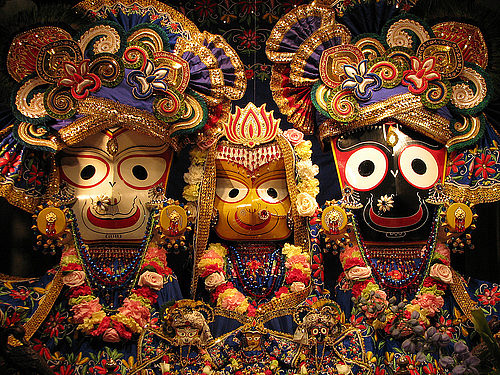Every year, as the giant wooden chariots roll through the streets of Puri, Odisha, millions of people gather with teary eyes, folded hands, and beating hearts. They come not just to catch a glimpse of the divine but to feel something deeply human like the joy, love, and unity symbolized by the three unique deities: Jagannath, Balabhadra, and Subhadra. These are not just gods on chariots. They are siblings, brother, brother, and sister, bound by blood, stories, emotions, and an extraordinary bond that reflects the core of human relationships.
Let’s take a closer look at who they are and what they truly represent—not only in religious terms, but in the context of society, values, and the very idea of divine family.
Jagannath: The Lord of the Universe
Jagannath, the central figure among the three, is often described as a form of Lord Krishna, an avatar of Vishnu. But in Odisha, he is more than just that, he is everyone’s god. His name itself means “Lord of the Universe” (Jagat = world, Nath = lord), suggesting that he is not limited by caste, religion, or geography.
What makes Jagannath so unique is his form. He doesn’t have hands or feet in the conventional sense. His eyes are wide and round, always open, watching over the world with love and concern. This incomplete form is actually a powerful message: even the divine is not perfect by form, but complete in spirit.
He reminds us that you don’t need to fit into an ideal mold to be loved or to be divine. There’s room for every being in his world, regardless of who they are or what they look like.
According to legends found in the Madala Panji, the construction of the first Jagannath temple was commissioned by King Indradyumna, a Malava king who is mentioned in the Mahabharata and the Puranas. So, who built the Jagannath temple? It was under King Indradyumna’s reign that the temple was established. He envisioned creating the tallest monument in the world for Lord Jagannath, measuring 1,000 cubits (about 457.2 meters) high. To consecrate the temple and the sacred images, he invited Brahma, the cosmic creator, to perform the rituals, marking the divine beginning of this iconic temple.
Balabhadra: The Elder Brother, Protector, and Strength
Standing tall next to Jagannath is Balabhadra, also known as Balarama, the elder brother of Krishna. He is always depicted in white, symbolizing purity, strength, and moral clarity. His face is more composed and his expression calm.
In family terms, Balabhadra represents the protective older sibling we all admire or wish we had. In the chariot festival, his chariot is pulled first, just like an elder brother who leads the way, making the path easier for the rest of the family.
He holds a plough, which is not just a farming tool, it symbolizes grounding. Where Jagannath represents compassion and cosmic play, Balabhadra brings the stability, patience, and strength needed to sustain life. He’s the reminder that spirituality must be rooted in values and resilience.
Subhadra: The Sister and the Soul of Balance
Right between the two brothers stands Subhadra, their beloved sister. Her presence on the same platform as her brothers is revolutionary in itself. In many traditions, the feminine is kept separate or secondary. But here, she is at the center, loved and revered equally.
Subhadra symbolizes grace, unity, and emotional intelligence. She’s the quiet strength that holds the family together. Her chariot is smaller, but that doesn’t mean she is less important. In fact, her central position in the Jagannath temple, right between the two powerful brothers, speaks volumes about balance.
She is the sister, but also a goddess in her own right, seen as a form of Durga or Shakti. In many ways, Subhadra reflects every woman who nurtures, mediates, and strengthens bonds in a family or society.
Symbolism of the Siblings Together
The three siblings together represent a divine family, something very relatable to ordinary people. Unlike distant, unapproachable gods, Jagannath, Balabhadra, and Subhadra walk with the people literally. That’s the whole point of the Ratha Yatra, or chariot festival. Once a year, they leave their temple and come down to the streets, just like family members who step out to greet others.
This act of leaving the temple also breaks down the idea that god must always be hidden or separated by rituals and hierarchies. It says, “Come see me. Come talk to me. I am yours too.” That’s why lakhs of people gather for this event—not just as a religious act, but as a shared emotional experience.
The three deities also remind us that divine love is not just about worship, but about relationships, between siblings, between people, and between human beings and the divine.
Cultural & Social Relevance
In today’s fast-paced world where family bonds often take a back seat, the story of the Jagannath siblings feels especially important. They remind us of the power of siblinghood, a bond not driven by transaction but by love, memory, and shared journey.
In a deeper way, they also reflect the values India holds dear, unity in diversity, inclusion, emotional closeness, and community celebration.
Whether you're pulling the chariot or watching from afar, there's a part of each of us in those wooden figures. We see our protective brothers, our loving sisters, and ourselves—imperfect, wide-eyed, hopeful, and longing for connection.
The beauty of Jagannath, Balabhadra, and Subhadra lies not just in the myths around them, but in how they mirror the everyday relationships we live with, filled with care, complexity, and commitment.
They are not distant gods seated on a throne. They are your elder brother, your younger sister, and your eternal friend, all rolled into one divine form. And as their chariots roll forward every year in Puri, they gently remind us:
Follow 카지노 Experiences:
| | |















